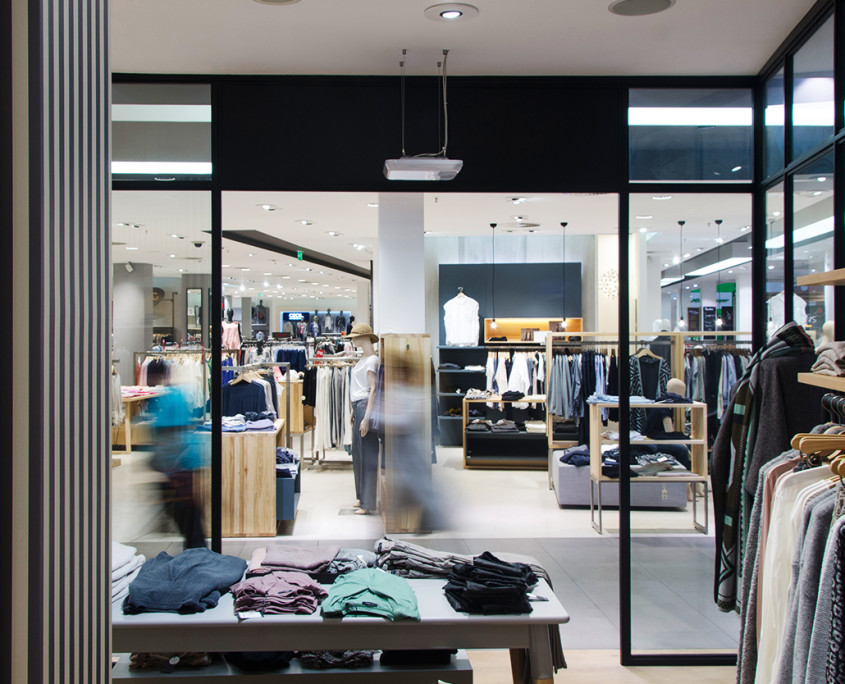The hidden options for EAS. The time is now

Due to their minimalist design and aesthetic appeal, concealed Security Systems or Electronic Article Surveillance (EAS) systems are an increasingly popular option for retailers looking to maintain item security, without the look of pedestals.
And there are a variety of options for retailers embracing this trend. From overhead surveillance to under floor systems and concealed receivers, new technology readily caters for a variety of retail environments.
So, as you undertake the task of working out whether a concealed system is right for your store, here’s a breakdown of the technology available and the essential factors you need to consider.
A quick overview
Concealed EAS systems are gaining popularity, with many major shopping malls now advocating these less obtrusive systems. The benefits of concealed systems include unobscured access to a store’s doorway and a more streamlined look.
Other than aesthetics, the systems work in the same manner as standard pedestal EAS, monitoring tags on RF or AM frequencies and alerting store personel when a tagged item leaves the store.
When selecting a concealed EAS system there are a number of factors to take into account, not least of which is ease of installation and expense. Due to the more complicated installation procedure involved with some concealed technology, systems can be more expensive. Their use may also be limited by the width or the doorway or the physical layout of a store.
Meanwhile, concealed systems also lack the visual theft deterrent provided by having a security system that’s on clear display. Deterrence is however supplied by the presence of visible security tags.
The good news is if concealed EAS is your desired course of action, there’s a wide range of technology designed to assist.
The technology
The past few years have seen major leaps and bounds in the area of concealed EAS as retailers opt for aesthetic appeal to welcome in the consumer. Available technology includes under floor systems, overhead monitoring, and surveillance technology concealed within doorframes.
So let’s take a look at what’s involved with each…
Under floor
Taking up no retail space and offering ultimate discretion, under floor EAS involves burying the EAS antenna in a concealed cavity at the doorway.
Popular EAS solutions like FloorGuard operates on the acousto magnetic (AM) frequency. The innovative antenna modules are available in 1.8m up to 3.6m widths with the installation of multiple modules catering to wider doorways.
FloorGuard is compatible with all AM frequency tags. Unlike other in floor systems recent improvements to FloorGuard ensure tag detection from the floor up to 1.8m high. It works beneath tiles, concrete or floorboards, and requires a 20mm cavity to bury the antenna system. Not all stores have this available depth beneath their flooring and this may affect whether this system is suitable for you.
Overhead
If beneath the floor doesn’t suit, then further technology offers the ability to monitor and track items from overhead, and iDTop by Nedap is among the leaders in this field.
This system utilises a small, square, overhead antenna that is positioned near the doorway. It is an RFID system compatible with coded RFID frequency tags and offers the capability to not only alert staff to theft, but also track items and assist with inventory management. iDTop is highly scalable and can be installed onto any door size.
The technology is scalable, meaning even if you haven’t fully embraced RFID, you can implement it when you’re ready without an EAS overhaul.
iDTop is extremely simple to install and caters for small and wide entrances and takes up no retail floor space. Its suitability may, however, be impacted by the height of your ceiling.
Within the doorframe
Available for various size door frames, another option is to conceal your EAS within a store’s entrance, without greatly impacting the floor.
Options like SkyGuard operate using an antenna system housed inside or around the door of an entrance. The technology works via two small receivers that are concealed within the sides of the doorway, and small cables that run around the doorframe.
Sky Guard operates on the AM frequency and can be installed in doorways up to 2.5m wide and 3m high. It requires easily accessible access panels either side of the door frame to house the receivers, and this can be factored into your’ store’s entrance design.
What to consider
While each system offers the benefit of improved aesthetics, the physical design of your store may impact which option is right for you.
Items to consider include:
- The frequency of your EAS tags – whether you use RF or AM.
- The width of your doorway – some systems are limited to smaller openings, while others require the installation of further modules to attain a greater width.
- The height of your ceiling – An overhead antenna will need to be positioned low enough to have products within range.
- The depth beneath your floor – If you’re looking at an under floor system you will require the construction of a concealed 20mm cavity to house the antenna. Not all stores have this depth.
- The look of your entrance – While they are not pedestals, some systems require the installation of panels to house the concealed antenna.
What next?
If you’re looking for further advice on the right option for you, Vitag is on hand to assist. We will help you find the most suitable concealed option and work with your shop fitter or designer, if required, to ensure your concealed EAS is not only appealing, but stands up to the job of keeping theft in check.